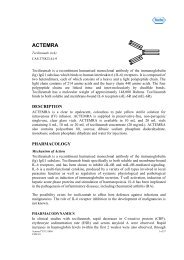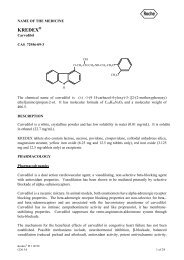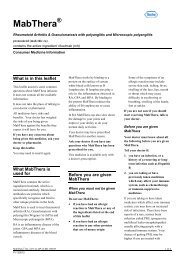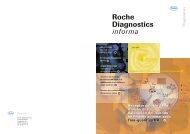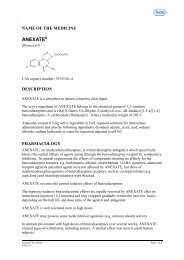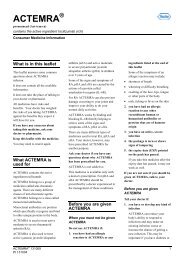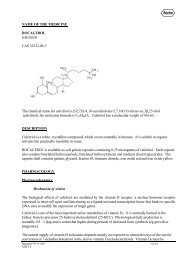Konakion MM Paediatric - Product Information (PI) - Roche Australia
Konakion MM Paediatric - Product Information (PI) - Roche Australia
Konakion MM Paediatric - Product Information (PI) - Roche Australia
Create successful ePaper yourself
Turn your PDF publications into a flip-book with our unique Google optimized e-Paper software.
abnormal coagulation status or bleeding due to vitamin K 1 deficiency and thereby reduces the risk of early,<br />
classic or late VKDB.<br />
Pharmacokinetics<br />
Absorption and Bioavailability<br />
Orally ingested phytomenadione is absorbed primarily in the middle portions of the small intestine.<br />
Optimum absorption is possible only in the presence of bile and pancreatic juice. The absolute<br />
bioavailability following intramuscular (IM) administration is approximately 80%. The onset of action<br />
occurs approximately 1-3 hours after intravenous (IV) administration and 4-6 hours after oral doses.<br />
Impaired gastrointestinal absorption may occur in conditions such as malabsorption syndromes, short bowel<br />
syndrome, biliary atresia and pancreatic insufficiency.<br />
Distribution<br />
The primary distribution compartment corresponds to the plasma volume. In blood plasma, 90% of vitamin<br />
K 1 is bound to lipo-proteins (VLDL portion). Vitamin K 1 plasma concentration is normally between 0.4<br />
and 1.2 ng/L. After IV administration of 10 mg <strong>Konakion</strong> <strong>MM</strong> to adults the plasma level after 1 hour is<br />
approximately 500 ng/mL and approximately 50 ng/mL at 12 hours. Vitamin K 1 is stored in the body for<br />
only short periods of time, does not readily cross the placenta and is poorly distributed into breast milk.<br />
Metabolism<br />
Vitamin K 1 is rapidly converted into more polar metabolites, including an active metabolite vitamin K 1 -2,3-<br />
epoxide. Some of this metabolite is reconverted into vitamin K 1 . Metabolism of vitamin K 1 after birth<br />
through epoxidation may occur more rapidly in premature infants.<br />
Elimination<br />
The elimination half-life in plasma is 1.5-3 hours. After metabolic degradation, vitamin K 1 is excreted in<br />
the bile and urine as the glucuronide and sulphate conjugates. Less than 10% of the medicine is excreted<br />
unchanged in the urine.<br />
INDICATIONS<br />
Prophylaxis and treatment of vitamin K deficiency bleeding (VKDB).<br />
CONTRAINDICATIONS<br />
<strong>Konakion</strong> <strong>MM</strong> <strong>Paediatric</strong> is contraindicated in patients with known hypersensitivity to any of the<br />
ingredients.<br />
PRECAUTIONS<br />
Anticoagulant Therapy<br />
<strong>Konakion</strong> <strong>MM</strong> <strong>Paediatric</strong> should be considered as adjunctive therapy to blood transfusions for severe<br />
haemorrhage due to anticoagulant therapy; it is not effective when heparin-like compounds have been used<br />
for anticoagulant therapy; minimal doses should be used to offset refractoriness to coumarin-like<br />
anticoagulants if long term anticoagulant therapy is intended.<br />
Effects on Fertility<br />
There have been no studies investigating the effect of phytomenadione on reproductive fertility.<br />
<strong>Konakion</strong> <strong>MM</strong> <strong>Paediatric</strong> ® <strong>PI</strong> 090703 2 of 5<br />
IS<strong>PI</strong> 2.0



